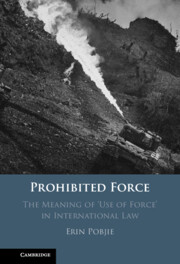104 results
Chapter 19 - Early Christian Philosophers on Concepts
-
-
- Book:
- Conceptualising Concepts in Greek Philosophy
- Published online:
- 25 April 2024
- Print publication:
- 02 May 2024, pp 427-451
-
- Chapter
- Export citation
Religion as Liberal Politics
-
- Journal:
- Journal of Law and Religion , First View
- Published online by Cambridge University Press:
- 29 April 2024, pp. 1-22
-
- Article
- Export citation
1 - Defining Misinformation
- from Part I - Setting the Stage
-
- Book:
- The Psychology of Misinformation
- Published online:
- 28 March 2024
- Print publication:
- 04 April 2024, pp 9-21
-
- Chapter
-
- You have access
- HTML
- Export citation
Conclusion
-
- Book:
- Prohibited Force
- Published online:
- 23 February 2024
- Print publication:
- 29 February 2024, pp 229-232
-
- Chapter
-
- You have access
- Open access
- HTML
- Export citation
Introduction
-
- Book:
- Prohibited Force
- Published online:
- 23 February 2024
- Print publication:
- 29 February 2024, pp 1-14
-
- Chapter
-
- You have access
- Open access
- HTML
- Export citation
Comment on: Definition of Clay and Clay Mineral: Joint Report of the AIPEA Nomenclature and CMS Nomenclature Committees
-
- Journal:
- Clays and Clay Minerals / Volume 44 / Issue 5 / October 1996
- Published online by Cambridge University Press:
- 28 February 2024, pp. 710-712
-
- Article
- Export citation

Prohibited Force
- The Meaning of ‘Use of Force' in International Law
-
- Published online:
- 23 February 2024
- Print publication:
- 29 February 2024
-
- Book
-
- You have access
- Open access
- Export citation
1 - The Populist Threat to Democracy
-
- Book:
- Democracy's Resilience to Populism's Threat
- Published online:
- 11 January 2024
- Print publication:
- 25 January 2024, pp 1-29
-
- Chapter
- Export citation
What is ‘Global Islam’? Definitions for a field of inquiry
-
- Article
-
- You have access
- Open access
- HTML
- Export citation
24 - Some Summing Up and Concluding Observations
- from Part III - The Period after the 1970s
-
- Book:
- Monitoring the State or the Market
- Published online:
- 07 December 2023
- Print publication:
- 21 December 2023, pp 193-200
-
- Chapter
- Export citation
Frequency of cognitive “super-aging” in three Australian samples using different diagnostic criteria
-
- Journal:
- International Psychogeriatrics , First View
- Published online by Cambridge University Press:
- 24 November 2023, pp. 1-17
-
- Article
- Export citation
Chapter 2 - What Is Narrative?
-
- Book:
- Applied Narrative Psychology
- Published online:
- 02 November 2023
- Print publication:
- 16 November 2023, pp 16-21
-
- Chapter
- Export citation
Introduction
-
-
- Book:
- The Cambridge Companion to the Sophists
- Published online:
- 23 December 2023
- Print publication:
- 19 October 2023, pp 1-30
-
- Chapter
- Export citation
Rethinking Health in Emergency Situations: A Holistic and Dynamic Approach
-
- Journal:
- Disaster Medicine and Public Health Preparedness / Volume 17 / 2023
- Published online by Cambridge University Press:
- 28 September 2023, e497
-
- Article
-
- You have access
- HTML
- Export citation
5 - Is ‘God’ the Name of God?
-
- Book:
- Naming God
- Published online:
- 30 June 2023
- Print publication:
- 20 July 2023, pp 83-112
-
- Chapter
- Export citation
2 - Defining Zoos, Their Culture and Visitors
-
- Book:
- Zoo Studies
- Published online:
- 12 May 2023
- Print publication:
- 01 June 2023, pp 12-42
-
- Chapter
- Export citation
1 - Introduction: Nationalists Think About the Economy
-
- Book:
- The Nationalist Dilemma
- Published online:
- 25 April 2023
- Print publication:
- 11 May 2023, pp 1-11
-
- Chapter
- Export citation
19 - Frontier Massacres in Australia, 1788–1928
- from Part III - Nineteenth-Century Frontier Genocides
-
-
- Book:
- The Cambridge World History of Genocide
- Published online:
- 23 June 2023
- Print publication:
- 04 May 2023, pp 461-480
-
- Chapter
- Export citation
Chapter 9 - Fetal Growth Restriction
- from Section 1 - Obstetric Aspects of Antenatal Care
-
-
- Book:
- OSCEs in Obstetrics and Maternal-Fetal Medicine
- Published online:
- 23 February 2023
- Print publication:
- 16 February 2023, pp 109-126
-
- Chapter
- Export citation
Chapter 1 - Introduction: What Is a Serial Killer?
-
- Book:
- Just as Deadly
- Published online:
- 06 January 2023
- Print publication:
- 09 February 2023, pp 1-16
-
- Chapter
- Export citation



